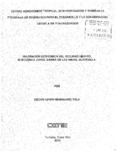Valoración económica del recurso hídrico, en la subcuenca Jones, Sierra de las Minas, Guatemala
Description
Tesis (Mag. Sc.)--CATIE, Turrialba (Costa Rica), 2001 130 p. 18 ilus. 22 tab. Bib. p. 118-122
Abstract
a destrucción ambiental está causando muchos problemas alrededor del mundo. Existe una separación entre economía -manejo de la casa- y ecología -conocimiento de la casa (Azqueta, 1994). La valoración de servicios ambientales es la solución planeada para minimizar las fallas de mercado en nuestras sociedades, porque la respuesta al problema del ingreso de los pobladores rurales debe ser encontrado a través de una producción amigable con el ambiente. La meta en la cuenca Jones es identificar ingresos para la población sin dañar el ambiente. La cobertura forestal está siendo reducida (108 ha año-1) durante los últimos 5 años) y ello afecta la cantidad de agua durante el verano, lo cual afecta la productividad agrícola y ganadera, e incluso pone en riesgo el consumo humano (Brown, et al. 1996). Este estudio se realizó en la subcuenca Jones, en la Biosfera de Sierra de las Minas, Guatemala. El propuesta aspira a generar información científica relacionada con el valor del agua -impulsando un "mecanismo de precios"- a través del pago por servicios ambientales: i) una tarifa a una empresa hidroeléctrica condicionada por el proceso de sedimentación en el embalse y sus costos asociados (US S ha-1), y ii) la estimación del precio (costo total) del metro cúbico de agua, derivado del costo de oportunidad del suelo (en términos de venta de madera y ganadería extensiva) más el costo de protección del bosque que garantice el servicio hidrológico (US S / m3). El análisis fue dinámico (20 años plazo), porque fue el tiempo necesario para computar el cambio del uso de la tierra (hacia ganadería, pasando por la interfase: venta de madera comercial). El estudio fue conducido en dos fases: recolección y análisis de información técnica y la aplicación de técnicas de valoración -costo de oportunidad, costo de protección y costos evitados-, las cuales fueron adaptadas a las condiciones de campo. Los resultados mostraron que el servicio ambiental de "protección de la calidad de agua" fue valorado en alrededor de US S 23 Ha-1 en el caso de la hidroeléctrica, y US 0.01/m3 por el servicio ambiental de "regulación hídrica" (equivalente a US 77 ha-1); los precios son similares a otros estudios (por ej. Costa Rica). La reciente firma del protocolo de Kyoto (del cual Guatemala es un signatario) y creación del Ministerio de Ambiente favorece la creación de un programa de servicios ambientales. En realidad, la información generada (las tarifas) es una contribución de base para la generación de políticas relacionadas con el manejo de agua. Los resultados pueden ser usados, siempre y cuando se realicen los ajustes correspondientes a otras cuencas. Esperemos que el siglo XXI sea recordado por un manejo sostenible de los recursos naturales, y no como su destructor. Environmental destruction is causing many problems around the earth. There exists a separation between economy -house management- and ecology -house knowledge- (Azqueta, 1994). The environmental service assessment is the solution for the market's failure in our societies, because the answer to the income problem must be found through environmentally friendly production. The goal within the Jones watershed is to identify incomes for the population without damaging the environmental. The forest cover has been reduced and it affects the amount of water during the summer, which affects the agricultural and livestock productivity and also puts at risk the human consumption (Brown et al, 1996). This study was carried out in Jones Watershed, within the Sierra de las Minas Biosphere, Guatemala. The aim of the proposal is to create scientific information regarding water value (monetary terms) through the estimation of payments for environmental services: i) Hydroelectric fee conditioned by the sedimentation process in the water storage and its associated costs (US S Ha-1), and ii) the estimation of water price (in cubic meters) using the opportunity cost (in terms of timber sale and extensive livestock) and protection cost of the forest (US S / m3). The analysis period was of twenty year because it was the time necessary for compute the land use change (from Pinus oocarpa to livestock, passing for sale timber). The study was conducted in two stages: collection and analysis of technical information and applied environmental techniques (cost of opportunity, protection cost and avoidance cost). In this way the techniques were adapted to the field conditions. A method has not yet been defined, because this type of investigation is new-it is a combination of many disciplines such as economy, forestry, hydrology, anthropology, geographic information to mention a few. The results showed the forest environmental service called quality water protection was valued at around US S 23.00 ha-1 in the hydroelectric case, and US S 0.01 per cubic meter for the service related to water regulation (like US 77 ha-1), the prices are very similar to other studies (i.e. Costa Rica). The Kyoto protocol signed recently (of which Guatemala is a participant) and the Government's Environment Affairs Ministry favor the emergence of an environmental service program. As a matter of fact, this information (the fees) is like basic contribution for the design of politics related with water management. The results can be used, but keeping in mind that they cannot be applied to other watersheds without the corresponding adjustment. It is the hope that the 21st century be remembered for the sustainable management of environmental resources, not as when it was destroyed.
Keywords
Publisher
CATIE, Turrialba (Costa Rica)
URI (Permanet link to cite or share this item)
https://repositorio.catie.ac.cr/handle/11554/10132Collections
- Tesis [3110]


